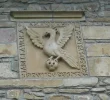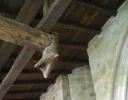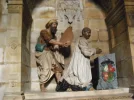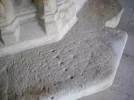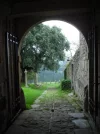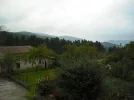sillydoll
Veteran Member
- Time of past OR future Camino
- 2002 CF: 2004 from Paris: 2006 VF: 2007 CF: 2009 Aragones, Ingles, Finisterre: 2011 X 2 on CF: 2013 'Caracoles': 2014 CF and Ingles 'Caracoles":2015 Logrono-Burgos (Hospitalero San Anton): 2016 La Douay to Aosta/San Gimignano to Rome:
Competition is made by walking
Of the 32 routes to Santiago, only one is a World Heritage Site. The Northern Way wants to be one. Another case like the Via de la Plata?
The controversy is served. Some of the most distinguished experts on the Camino de Santiago, as the Pablo Arribas, have already voiced opposition to extending the Unesco World Heritage Site declaration to the so-called Northern Route, which passes through the communities of the Basque Country, Cantabria, Asturias and Galicia.
Although there are many 'roads', only one, the so-called French, from Roncesvalles to Compostela, has the recognition of the Paris-based agency.
"It is a further invention, and they will end up spoiling" Burgos adventure writer, author of “Pícaros y picaresca en el Camino de Santiago” (Rogues and the picaresque in the Camino de Santiag), one of the most documented and best publications written to understand the ancient pilgrimage route.
On 21 December, representatives from the four autonomous communities of Cantabria met at the collegiate Zenarruza in the village of Markina Biscay. The meeting was also attended by a representative of the Ministry of Culture. The dossier to be referred to the headquarters of Unesco which is expected next year, aims at the expansion of the statement that in 1993 the organization awarded the French way.
Arribas is among the few who has raised his voice. He believes that the only interest of these autonomies is to promote a sector such as tourism. "Even some of the most distinguished scholars have concluded that the Northern Route was not as important as now intended, among other reasons because it was much longer," adds the historian, who also based his critical thinking "in the picaresque imperative that seeks to capture the prestige of the Camino de Santiago ".
Leon is long, the province with more miles in the French route has over 200kms between Sahagun and height of Cebreiro. The president of the Association of Friends of the Camino de Santiago de León, Beatriz Gallego, is not so vehement. He has entered the controversy, but argues that the "natural path" is the French way. "So it has been for many centuries. It was the busiest, "he insists.
Beatriz Gallego does not deny the historical links of the North Road as it was always a Christian area. "But by that token, also others 'paths' deserve such recognition," she adds.
The forecast of the Board and the Central Government is that this year St. James, by the French Way, will have more than 200,000 pilgrims. There are more reasons, but increasing the number of visitors is one of the great Cantabrian project objectives.
"The nomination is in the indicative list, this means that the Government of Spain has it among its priorities," explains the CEO of Heritage of Asturias, Jose Luis Vega.
Currently, the Northern Route enjoys the declaration of a Cultural (BIC), but does not even remotely compare with infrastructure of the French Way. Some municipalities, like Aviles, have already announced they want to join the initiative by opening a shelter. The Northern Way enters Spain through Irun and runs throughout the Cantabrian coast. Along its route has several paths cross to join the French way. In La Rioja, Burgos, in Leon. Perhaps the most important is the route of San Salvador, linking with Leon Oviedo. "Neither can be neglected, but the Northern Way, if something is important, is the landmark of San Salvador" insists Paul Arribas.
"It's a place of pilgrimage and encounter between people and peoples through the centuries and has become a symbol of brotherhood and structuring of a European consciousness," says the Basque Government to support the initiative.
Some see this idea an attempt by the principality, in particular, lend a ember of his sardine, as in the controversy of the Via de la Plata. "Whoever goes to James and not the Savior, visited the man and not the Lord," reads a famous song. Perhaps the question remains is why did not ask before the declaration of Unesco, which has been almost 20 years.
http://www.la-cronica.net/2010/01/10/7- ... -64190.htm
Of the 32 routes to Santiago, only one is a World Heritage Site. The Northern Way wants to be one. Another case like the Via de la Plata?
The controversy is served. Some of the most distinguished experts on the Camino de Santiago, as the Pablo Arribas, have already voiced opposition to extending the Unesco World Heritage Site declaration to the so-called Northern Route, which passes through the communities of the Basque Country, Cantabria, Asturias and Galicia.
Although there are many 'roads', only one, the so-called French, from Roncesvalles to Compostela, has the recognition of the Paris-based agency.
"It is a further invention, and they will end up spoiling" Burgos adventure writer, author of “Pícaros y picaresca en el Camino de Santiago” (Rogues and the picaresque in the Camino de Santiag), one of the most documented and best publications written to understand the ancient pilgrimage route.
On 21 December, representatives from the four autonomous communities of Cantabria met at the collegiate Zenarruza in the village of Markina Biscay. The meeting was also attended by a representative of the Ministry of Culture. The dossier to be referred to the headquarters of Unesco which is expected next year, aims at the expansion of the statement that in 1993 the organization awarded the French way.
Arribas is among the few who has raised his voice. He believes that the only interest of these autonomies is to promote a sector such as tourism. "Even some of the most distinguished scholars have concluded that the Northern Route was not as important as now intended, among other reasons because it was much longer," adds the historian, who also based his critical thinking "in the picaresque imperative that seeks to capture the prestige of the Camino de Santiago ".
Leon is long, the province with more miles in the French route has over 200kms between Sahagun and height of Cebreiro. The president of the Association of Friends of the Camino de Santiago de León, Beatriz Gallego, is not so vehement. He has entered the controversy, but argues that the "natural path" is the French way. "So it has been for many centuries. It was the busiest, "he insists.
Beatriz Gallego does not deny the historical links of the North Road as it was always a Christian area. "But by that token, also others 'paths' deserve such recognition," she adds.
The forecast of the Board and the Central Government is that this year St. James, by the French Way, will have more than 200,000 pilgrims. There are more reasons, but increasing the number of visitors is one of the great Cantabrian project objectives.
"The nomination is in the indicative list, this means that the Government of Spain has it among its priorities," explains the CEO of Heritage of Asturias, Jose Luis Vega.
Currently, the Northern Route enjoys the declaration of a Cultural (BIC), but does not even remotely compare with infrastructure of the French Way. Some municipalities, like Aviles, have already announced they want to join the initiative by opening a shelter. The Northern Way enters Spain through Irun and runs throughout the Cantabrian coast. Along its route has several paths cross to join the French way. In La Rioja, Burgos, in Leon. Perhaps the most important is the route of San Salvador, linking with Leon Oviedo. "Neither can be neglected, but the Northern Way, if something is important, is the landmark of San Salvador" insists Paul Arribas.
"It's a place of pilgrimage and encounter between people and peoples through the centuries and has become a symbol of brotherhood and structuring of a European consciousness," says the Basque Government to support the initiative.
Some see this idea an attempt by the principality, in particular, lend a ember of his sardine, as in the controversy of the Via de la Plata. "Whoever goes to James and not the Savior, visited the man and not the Lord," reads a famous song. Perhaps the question remains is why did not ask before the declaration of Unesco, which has been almost 20 years.
http://www.la-cronica.net/2010/01/10/7- ... -64190.htm




